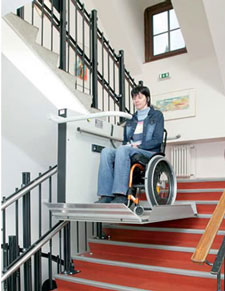What a wheelchair platform stairlift is and does
For wheelchair users a traditional stairlift (where the person is moved up and down the stairs on a seat) is not an ideal option. Not only does this require two wheelchairs in the house (one for downstairs and the other for upstairs), but transferring between the stairlift seat and the wheelchairs is both tiring and possibly dangerous (especially at the top of the staircase).
One solution which wheelchair users can use for moving up and down the stairs is a wheelchair platform stairlift (also called an inclined platform lift). This is basically a traditional stairlift which has a platform for moving wheelchairs instead of a seat.
If you are considering installing one in your or a relative's home, there are a few things you need to know before you purchase one or start contacting companies.
The main parts of a wheelchair platform stairlift
It has three main parts:

- The main body
- The platform
- The rail(s)
The main body
The body of the lift is the rectangular part which is vertical and faces the wall/banister. This contains the motor which moves the lift and the battery which powers the motor. In addition to these, the body also has a control panel on the front for operating the lift and two fold away barrier arms (which are raised/lowered automatically) for safety attached to the sides.
The platform
The platform is the part used to carry the wheelchair. It is attached with a powered hinge at the bottom of the main body. The platform has two positions: vertical (when not in use or not transporting somebody) and horizontal (when carrying somebody). In addition, three of the sides of the platform (except the side facing the main body) have small ramps on the edges.
As a safety measure, whilst the lift is being used, all these ramps are in an upright position. One or more of these is automatically lowered when a person is getting on or off the lift.
The rail(s)
The last part of the lift is the rail(s). Depending on the make and model of the lift, there is either one or two rails. If there are two, one of the rails is used for moving the lift up and down the staircase, while the other is used to support the weight of the lift. If there is one rail, it will do both.
Can be fitted to most staircases
The minimum width which most reputable manufacturers and installers will need to fit a stairlift on a staircase is around 84 cm (33 inches). But this depends on the width of the platform which you need to safely fit your wheelchair on (the width of the platforms can range from 70cm to 90cm). The wider the platform, the wider the stairs need to be.
In addition, they can be fitted to either straight staircases or staircases which are curved or have a bend in them.
Where they are attached
Depending on the model and the company, some are attached to the actual stairs (with supports added), others are attached to the wall on the side of the staircase, while others are attached to both.
For narrow staircases, having the stairlift attached to the wall is the better opinion because the machine occupies less space when it is parked (not in use) and the platform is folded in its vertical position.
How they are controlled
There are two ways to control the movement of this type of stairlift: From the lift itself and by remote control.
The controls on the lift are on the front of the main body (the part facing the wall or banister which contains the motor and battery). Depending on the make or model, the movement of the lift is controlled by pressing buttons, a lever or a mini-joystick.
In addition to the controls on the main body of the lift, you can also move it with a remote control device. Most wheelchair platform lifts will come with two remote controls. Normally, each will have four buttons on them. The first two are to move the stairlift either up or down the stairs. The last two are used to either raise or lower the platform.
The remote controls can be both used to call the stairlift when nobody is on it (handy if more than one person uses the lift) or to remotely move somebody on the lift.
Often these remote controls will be attached to the wall at the top and bottom of the stairs.
The platform is level as it moves
When being used by a wheelchair, the platform is at a 180 degree angle throughout the entire journey. This prevents the wheelchair from moving.
Getting on and off the lift
Getting on and off the lift with a wheelchair is easy and safe to do. When the lift arrives at the place you want to get on it, you press a button on the remote control to lower both the platform to the floor and the barrier arms (the front barrier arm will lower less than the one at the back to allow you to get onto the platform). When the platform is in position, one or more of the ramps around the edge will lower to allow you to move onto the platform.
Once the wheelchair is in position on the lift's platform, you put the brakes on the wheelchair on and press the button on the main body of the lift to start the journey. When this happens, all the ramps around the edge of the platform will move into a vertical position and the front barrier arm will lower and then you start moving.
When you arrive at the place to get off, the barrier arm facing the exit will raise and one or more of the ramps on the platform will lower. You then take the breaks off on your wheelchair and leave the platform.
It is advisable at the top of the stairs that you enter onto the platform facing forwards. When you enter the platform at the bottom of the stairs, make sure that when you get onto the platform that you are facing forwards as the lift moves upwards.
Where are they parked when not in use
When not in use, you press a button to make the platform of the stairlift fold upwards to a vertical position facing the wall or banister. This is to ensure that the staircase can be used safely by people walking up and down the stairs.
Where the stairlift is parked when not in use depends on the type of rail/track it runs on (a straight rail or a curved rail) and the space that is available at either the bottom or top of the staircase.
On a straight rail, the stairlift is parked at either at the bottom in the hallway before the actual staircase starts or at the top over the last steps of the staircase, level with the landing.
On a curved rail, the stairlift can be parked like above or around the side of the staircase (at either the top or bottom) or further away from the beginning or ending of the staircase. For example, you can park the stairlift on the actual landing and not over the last step of the staircase.
Power
Most modern wheelchair platform stairlifts are powered by a rechargeable battery inside the main body. The advantage of this is if you there is a power cut/outage, the stairlift can still be used. The battery is recharged by mains electricity when the stairlift is parked (at the bottom or the top of the stairs).
There are some older models of stairlifts which use electricity directly from the mains to move. Most of these which do, have a battery as a backup. So, if there is a power cut, they still can be used.
Speed
As you can imagine, they don't move very fast for obvious reasons. Most wheelchair platform stairlifts only have one speed and this is significantly less than one mile an hour.
Weight restrictions
All wheelchair platform stairlifts have a recommended weight limit for use (the combined weight of the person and the wheelchair). Fortunately, this is quite a lot on most models (around 47 stone (660 pounds)). This should be more than enough for the majority of people with a traditional type of wheelchair.
The cost
Because there is less demand for this type of stairlift and they cost more to manufacture and take longer to install, wheelchair platform stairlifts are generally more expensive to buy than a traditional seated stairlift. You are generally looking at paying around $2,000 (£1,600) more than you would for a traditional stairlift.
They are safe
As long as you follow the instructions on getting on and off the platform and put on the wheel brakes as soon as you are in position on the platform, they are perfectly safe (they wouldn't be sold and installed if they weren't).
Even so, in my experience there are some people who still don't feel very safe or comfortable when using them. So, before you buy one, I would recommend that you do the following.
Try one before you buy
As I mentioned above, although these stairlifts are perfectly safe to use, some people don't feel safe or comfortable when using them. Even though most of these get used to using them, some don't. So, I strongly urge you to try using one (or get the person it is intended for to use one) before buying one.
If you don't know anybody who has one, most companies who sell and fit them will have demonstration models (either in the offices of the company or in the house of one of their customers). So ask them if you can try one.

